Chapter 1. The Study of Life
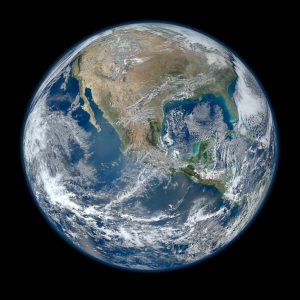
Chapter Outline
- 1.1 The Study of Biology
- 1.2 Themes and Concepts of Biology
Introduction
Viewed from space, Earth offers no clues about the diversity of life forms that reside there. The first forms of life on Earth are thought to have been microorganisms that existed for billions of years in the ocean before plants and animals appeared. The mammals, birds, and flowers so familiar to us are all relatively recent, originating 130 to 200 million years ago. Humans have inhabited this planet for only the last 2.5 million years, and only in the last 200,000 years have humans started looking like we do today.
1.1 | The Study of Biology
Learning Objectives
By the end of this section, you will be able to:
- Describe the science of biology.
- Summarize the steps of the scientific method.
What is biology? In simple terms, biology is the study of living organisms and their interactions with one another and their environment. This is a very broad definition because the scope of biology is vast. Biologists may study anything from the microscopic or submicroscopic view of a cell to ecosystems and the whole living planet (Figure 1.1). Listening to the daily news, you will quickly realize how many aspects of biology are discussed every day. For example, recent news topics include Escherichia coli (Figure 1.2) outbreaks in spinach and Salmonella contamination in peanut butter. Other subjects include efforts toward finding cures for diseases such as AIDS, Alzheimer disease, and cancer. On a global scale, many researchers are committed to finding ways to protect the planet, solve environmental issues, and reduce the effects of climate change. All of these diverse endeavors are related to different facets of the discipline of biology.

1.1.1 The Process of Science
Biology is a science, but what exactly is science? What does the study of biology share with other scientific disciplines? Science (from the Latin scientia, meaning “knowledge”) can be defined as the process of acquiring knowledge about general truths or the operation of general laws, especially when acquired and tested by the scientific method. It becomes clear from this definition that the application of the scientific method plays a major role in science. The scientific method is a method of research with defined steps that include experiments and careful observation.
The steps of the scientific method will be examined in detail later, but one of the most important aspects of this method is the testing of hypotheses by means of repeatable experiments. A hypothesis is a suggested explanation for an event, which can be tested. Although using the scientific method is inherent to science, it is inadequate in determining what science is. This is because it is relatively easy to apply the scientific method to disciplines such as physics and chemistry, but when it comes to disciplines like archaeology and geology, the scientific method becomes less applicable as it becomes more difficult to repeat experiments.
These areas of study are still sciences, however. Consider archeology—even though one cannot perform repeatable experiments, hypotheses may still be supported. For instance, an archeologist can hypothesize that an ancient culture existed based on finding a piece of pottery. Further hypotheses could be made about various characteristics of this culture, and these hypotheses may be found to be supported or false from other findings. Over time, as hypotheses continue to be supported, they may contribute to the formulation of a theory. A theory is a tested and confirmed explanation that fits all of the observations or phenomena in a given field of study.
Not surprisingly, the natural science of biology has many branches or subdisciplines. Cell biologists study cell structure and function, while biologists who study anatomy investigate the structure of an entire organism. Those biologists studying physiology focus on the internal functioning of an organism. Some areas of biology focus on only particular types of living things. For example, botanists explore plants, while zoologists specialize in animals.
1.1.2 The Scientific Method
Biologists study the living world by posing questions about it and seeking verifiable responses. This approach is common to other sciences as well and is often referred to as the scientific method. The scientific method was used even in ancient times, but it was first documented by England’s Sir Francis Bacon (1561–1626), who set up inductive methods for scientific inquiry. The scientific method can be applied to almost all fields of study as a logical, rational problem-solving method.
The scientific process typically starts with an observation that leads to a question. Let’s think about a simple problem that starts with an observation and apply the scientific method to solve the problem. One Monday morning, a student arrives at class and quickly discovers that the classroom is too warm. That is an observation that also describes a problem: the classroom is too warm. The student then asks a question: “Why is the classroom so warm?”
Proposing a Hypothesis
Recall that a hypothesis is a suggested explanation that can be tested. To solve a problem, several hypotheses may be proposed. For example, one hypothesis might be, “The classroom is warm because no one turned on the air conditioning.” But there could be other responses to the question, and therefore other hypotheses may be proposed. A second hypothesis might be, “The classroom is warm because there is a power failure, and so the air conditioning doesn’t work.”
Once a hypothesis has been formulated, the student can make a prediction. A prediction is similar to a hypothesis but it typically has the format “If . . . then . . . .” For example, the prediction for the first hypothesis might be, “If the student turns on the air conditioning, then the classroom will no longer be too warm.”
Testing a Hypothesis
A valid hypothesis must be testable. It should also be falsifiable, meaning that it can be disproven by experimental results. Importantly, science does not claim to “prove” anything because scientific understandings are always subject to modification with further information. This step—openness to disproving ideas—is what distinguishes sciences from non-sciences. The presence of the supernatural, for instance, is neither testable nor falsifiable.
To test a hypothesis, a researcher will conduct one or more experiments designed to eliminate one or more of the hypotheses. Each experiment will have one or more variables and one or more controls. A variable is any part of the experiment that can vary or change during the experiment. Control variables are variables that are held constant in all parts of the experiment. The experimental variable is the one that is changed. Many experiments are designed to test whether one variable, the dependent variable, is influenced by another variable, the independent variable. The researcher manipulates, or investigates several cases of, the independent variable and observes changes in the dependent variable. For example, if a scientist hypothesizes that coat color in rabbits is influenced by temperature, she may observe rabbits at different temperatures (the independent variable) and observe the coat color (the dependent variable) in each case.
To test the first hypothesis in the above example, the student would find out if the air conditioning is on. If the air conditioning is turned on but does not work, this hypothesis should be rejected. To test the second hypothesis, the student could check if the lights in the classroom are functional. If so, there is no power failure and this hypothesis should be rejected. Be aware that rejecting one hypothesis does not determine whether or not the other hypotheses can be accepted; it simply eliminates one hypothesis that is not valid. Using the scientific method, the hypotheses that are inconsistent with experimental data are rejected (Figure 1.3).
The scientific method may seem too rigid and structured. It is important to keep in mind that, although scientists often follow this sequence, there is flexibility. Sometimes an experiment leads to conclusions that favor a change in approach; often, an experiment brings entirely new scientific questions to the puzzle. Many times, science does not operate in a linear fashion; instead, scientists continually draw inferences and make generalizations, finding patterns as their research proceeds. Scientific reasoning is more complex than the scientific method alone suggests. Notice, too, that the scientific method can be applied to solving problems that are not necessarily scientific in nature.

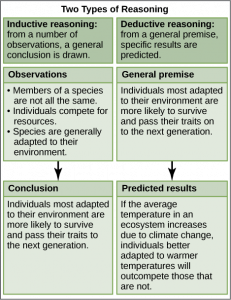
Concept Check
Decide if each of the following is an example of inductive or deductive reasoning.
- All flying birds and insects have wings. Birds and insects flap their wings as they move through the air. Therefore, wings enable flight.
- Insects generally survive mild winters better than harsh ones. Therefore, insect pests will become more problematic if global temperatures increase.
- Chromosomes, which are made of DNA, pass genetic information from parent to offspring during cell division. Therefore, DNA is the genetic material.
- Animals as diverse as humans, insects, and wolves all exhibit social behavior. Therefore, social behavior must have an evolutionary advantage.
Concept Check
In the example below, the scientific method is used to solve an everyday problem.
- Order the scientific method steps (numbered items).
- Match these steps with the processes of solving the problem (lettered items).
- Based on the results of the experiment, is the hypotheses correct? If it is incorrect, propose some alternate hypotheses.
| 1. Experiment | a. There is something wrong with the electrical outlet. |
| 2. Prediction | b. If something is wrong with the electrical outlet, my coffeemaker also won’t work when plugged into it. |
| 3. Question | c. My toaster doesn’t toast my bread. |
| 4. Observation | d. I plug my coffeemaker into the outlet. |
| 5. Result | e. My coffeemaker works. |
| 6. Hypothesis | f. Why doesn’t my toaster work? |
1.1.3 Reporting Scientific Work
Whether scientific research is basic science or applied science, scientists must share their findings in order for other researchers to expand and build upon their discoveries. Collaboration with other scientists—when planning, conducting, and analyzing results—are all important for scientific research. For this reason, important aspects of a scientist’s work are communicating with and disseminating results to peers.
Scientists can share results by presenting them at a scientific meeting or conference, but this approach can reach only the select few who are present. Instead, most scientists present their results in peer-reviewed manuscripts that are published in scientific journals. Peer-reviewed manuscripts are scientific papers that are reviewed by a scientist’s colleagues, or peers. These colleagues are qualified individuals, often experts in the same research area, who judge whether or not the work is suitable for publication. The process of peer review helps to ensure that the research described in a scientific paper or grant proposal is original, significant, logical, and thorough. Grant proposals, which are requests for research funding, are also subject to peer review. Scientists publish their work so other scientists can reproduce their experiments under similar or different conditions to expand on the findings. The experimental results must be consistent with the findings of other scientists.
A scientific paper is very different from creative writing. Although creativity is required to design experiments, there are fixed guidelines when it comes to presenting scientific results. Scientific writing must be brief, concise, and accurate. Most scientific papers consist of the following:
Abstract: a concise summary of the results of the study
Introduction: background information about what is known in the field as well as the rationale of the work
Materials and Methods: complete and accurate description of the substances used, and the methods and techniques used by the researchers to gather data. The description should be thorough enough to allow another researcher to repeat the experiment and obtain similar results. This section will also include information on how measurements were made and what types of calculations and statistical analyses were used.
Results and/or Discussion: description of the findings, usually by means of tables or graphs. The researcher will interpret the results, describe how variables may be related, and attempt to explain the observations.
Conclusion: summary of the importance of the experimental findings.
References: It is indispensable to conduct an extensive literature search to put the results in the context of previously published scientific research. Therefore, proper citations are included in this section.
Review articles do not present original scientific findings, or primary literature; instead, they summarize and comment on findings that were published as primary literature and typically include extensive reference sections.
1.2 | Themes and Concepts of Biology
Learning Objectives
By the end of this section, you will be able to:
- Identify and describe the properties of life.
- Describe the levels of organization among living things.
- Summarize the three unifying theories of biology.
- Name and briefly characterize the three domains of life on Earth.
Biology is the science that studies life, but what exactly is life? This may sound like a silly question with an obvious response, but it is not always easy to define life. For example, a branch of biology called virology studies viruses, which exhibit some of the characteristics of living entities but lack others. It turns out that although viruses can attack living organisms, cause diseases, and even reproduce, they do not meet all of the criteria that most biologists use to define life.
From its earliest beginnings, biology has wrestled with three questions: What are the shared properties that make something “alive”? And once we know something is alive, how do we find meaningful levels of organization in its structure? And, finally, when faced with the remarkable diversity of life, how do we organize the different kinds of organisms so that we can better understand them? As new organisms are discovered every day, biologists continue to seek answers to these and other questions.
1.2.1. Properties of Life
All living organisms share several key characteristics or functions: order, sensitivity or response to the environment, reproduction, growth and development, regulation, homeostasis, energy processing, adaptation, and evolution. When viewed together, these nine characteristics serve to define life.
Order
Organisms are highly organized, coordinated structures that consist of one or more cells. Even very simple, single-celled organisms are remarkably complex: inside each cell, atoms make up molecules; these in turn make up cell organelles and other cellular inclusions. In multicellular organisms (Figure 1.5), similar cells form tissues. Tissues, in turn, collaborate to create organs (body structures with a distinct function). Organs work together to form organ systems.

Sensitivity or Response to Stimuli
Organisms respond to diverse stimuli. For example, plants can bend toward a source of light, climb on fences and walls, or respond to touch (Figure 1.6). Even tiny bacteria can move toward or away from chemicals (a process called chemotaxis) or light (phototaxis). Movement toward a stimulus is considered a positive response, while movement away from a stimulus is considered a negative response.

Reproduction
Single-celled organisms reproduce by first duplicating their DNA, and then dividing it equally as the cell prepares to divide to form two new cells. Multicellular organisms often produce specialized reproductive cells that will form new individuals. When reproduction occurs, genes containing DNA are passed along to an organism’s offspring. These genes ensure that the offspring will belong to the same species and will have similar characteristics (Figure 1.7).

Growth and Development
Organisms grow and develop following specific instructions coded for by their genes. These genes provide instructions that will direct cellular growth and development, ensuring that a species’ young will grow up to exhibit many of the same characteristics as its parents (Figure 1.7).
Regulation and Homeostasis
Even the smallest organisms are complex and require multiple regulatory mechanisms to coordinate internal functions, respond to stimuli, and cope with environmental stresses. Two examples of internal functions regulated in an organism are nutrient transport and blood flow. Organs (groups of tissues working together) perform specific functions, such as carrying oxygen throughout the body, removing wastes, delivering nutrients to every cell, and cooling the body.
In order to function properly, cells need to have appropriate conditions such as proper temperature, pH, and appropriate concentration of diverse chemicals. These conditions may, however, change from one moment to the next. Organisms are able to maintain internal conditions within a narrow range almost constantly, despite environmental changes, through homeostasis (literally, “steady state”)—the ability of an organism to maintain constant internal conditions. For example, an organism needs to regulate body temperature through a process known as thermoregulation. Organisms that live in cold climates have body structures, including fur, feathers, blubber, and fat, that help them withstand low temperatures and conserve body heat. Structures that aid in this type of insulation In hot climates, organisms have methods (such as perspiration in humans or panting in dogs) that help them to shed excess body heat.

Energy Processing
All organisms use a source of energy for their metabolic activities. Some organisms capture energy from the sun and convert it into chemical energy in food; others use chemical energy in molecules they take in as food (Figure 1.9).

Adaptation and Evolution
All organisms have DNA as the genetic material that allows parents to pass traits to their offspring. Due to the changeability of DNA, variability is introduced into populations as they reproduce. This causes species to change over time, or evolve. As variability increases, new species come into being (Figure 1.10). The mechanisms of this process will be discussed later.

1.2.2 Levels of Organization of Living Things
Living things are highly organized and structured, following a hierarchy that can be examined on a scale from small to large. The atom is the smallest and most fundamental unit of matter. It consists of a nucleus surrounded by electrons. Atoms form molecules. A molecule is a chemical structure consisting of at least two atoms held together by one or more chemical bonds. Many molecules that are biologically important are macromolecules, large molecules that are typically formed from repeating units. An example of a macromolecule is deoxyribonucleic acid (DNA) (Table 1.1), which contains the instructions for the structure and functioning of all living organisms.
Table 1.1 The biological levels of organization of living things from small to large. From a single organelle to the entire biosphere, living organisms are parts of a highly structured hierarchy. (Credit “macromolecules”: “Geoff Hutchison”/Flickr; credit “organelles”: “Przemyslawtarka95″/Wikimedia Commons; Credit “cells”: “Steve Begin”/Flickr; Credit “tissues”: “Circa24″/Wikimedia Commons; credit “organs”: anatomical drawing by Leonardo da Vinci; credit “organisms”: “dmitry.kaglik”/Flickr; credit “ecosystems”: “USFWS – Pacific Region”/Flickr; credit “biosphere”: GSFC/NASA Goddard.)
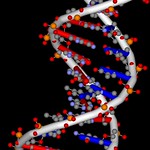 |
Macromolecules – Ex: DNA double helix | |
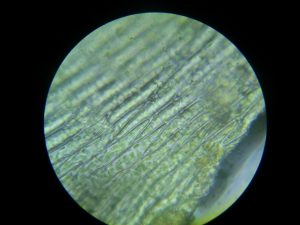 |
Organelles – Ex: chloroplasts in plant cells | |
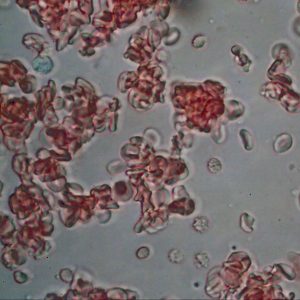 |
Cells – Ex: human red blood cells | |
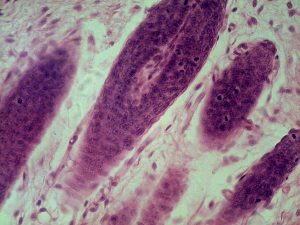 |
Tissues – Ex: hair follicles in mammalian skin | |
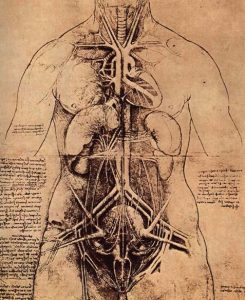 |
Organs and organ systems – Ex: “The Principal Organs and Vascular and Urino-Genital Systems of a Woman” | |
 |
Organisms, populations and communities – Ex: pine trees in a forest community | |
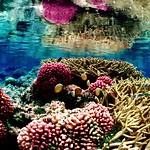 |
Ecosystems – Ex: coral reef ecosystem | |
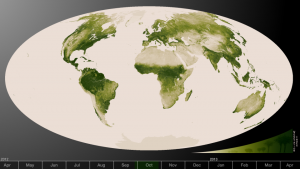 |
Biosphere – The sum of all ecosystems on Earth |
Some cells contain small structures that exist within cells surrounded by membranes; these are called organelles. All living things are made of cells; the cell itself is the smallest fundamental unit of structure and function in living organisms. Some organisms consist of a single cell and others are multicellular.
In larger organisms, cells combine to make tissues, which are groups of similar cells carrying out similar or related functions. Organs are collections of tissues grouped together performing a common function. An organ system is a higher level of organization that consists of functionally related organs. Mammals have many organ systems, including the circulatory system and the digestive system. Organisms are individual living entities. For example, each tree in a forest is an organism. Some organisms are composed of a single cell.
All the individuals of a species living within a specific area are collectively called a population. For example, a forest may include many pine trees. All of these pine trees represent the population of pine trees in this forest. Different populations may live in the same specific area. For example, the forest with the pine trees includes populations of flowering plants and also insects and microbial populations. A community is the sum of populations inhabiting a particular area. For instance, all of the trees, flowers, insects, and other populations in a forest form the forest’s community. The forest itself is an ecosystem. An ecosystem consists of all the living things in a particular area together with the abiotic, non-living parts of that environment such as nitrogen in the soil or rain water. At the highest level of organization (Table 1.1), the biosphere is the collection of all ecosystems, and it represents the zones of life on Earth. It includes land, water, and the atmosphere.
Concept Check
Which of the following statements is false?
- Tissues exist within organs which exist within organ systems.
- Communities exist within populations which exist within ecosystems.
- Organelles exist within cells which exist within tissues.
- Communities exist within ecosystems which exist in the biosphere.
1.2.3 The Three Unifying Theories of Biology
Scientists use the word theory differently than non-scientists do. In science, a theory is an explanation that encompasses all of the known information in a field of study. Although theories can continue to be modified, they are almost never replaced or dismissed entirely. Three of the most important theories in biology are cell theory, the chromosomal theory of inheritance, and the theory of evolution by natural selection. The details of these theories will be covered in later chapters, or in the case of evolution by natural selection, in other courses. The basic principles of these theories are described briefly below.
Cell Theory
Cell theory states that all living things are composed of cells, that cells are the basic unit of life, and that cells come from pre- existing cells. All cells have the same basic structure of a gel-like cytoplasm enclosed by a double layer of lipid molecules called the plasma membrane. In addition, all cells contain DNA as the genetic material.
How did the first cells come into existence? Most scientists think that conditions on early Earth were ideal for the formation of living cells. The early seas were warm, contained a large number of carbon-based molecules, and had a lot of energy input from lightening and volcanos. Sometime around 3.5 billion years ago, carbon-based molecules became surrounded by lipid molecules and evolved the ability to reproduce. This was the first cell. Other scientists postulate that life may have arrived on earth from space on an asteroid or meteor. Since conditions on earth no longer support the formation of life, cells can only come from pre-existing cells at this time on Earth.
The Chromosomal Theory of Inheritance
The chromosomal theory of inheritance states that chromosomes carry the genetic material. Chromosomes are made of a single very long molecule of DNA wrapped around proteins that serve to pack it tightly into a cell (Figure 1.11). Segments of the chromosome called genes code for traits, or characteristics. Chromosomes are passed on from parents to offspring, which is the basis of inheritance.

The Theory of Evolution by Natural Selection
Species change over time, or evolve. In 1869, Charles Darwin and Alfred Russel Wallace proposed a mechanism, called natural selection, for this observed evolution. They proposed that since not all of the members of a population can survive, the ones who are most fit will survive and reproduce at a higher rate and will therefore be more likely to pass on their traits. Therefore, over time, the characteristics that are present in a population will change. As populations change, new species come into existence.
For natural selection to work, there must first be variation among individuals in a population. The variation arises through changes in the DNA, which leads to changes in the traits of individuals. Secondly, there must be a selective pressure, such as a shortage of food, a predator, a mating preference, etc. For example, if the selective pressure is a predator, individuals who are best able to avoid being eaten will survive and reproduce at a higher rate. Individuals may have different types of fitness: some may be able to move faster, others may be able to hide better, while still others may be able to convince the predator that they are poisonous. Regardless, some individuals get eaten and some survive. The final important part is that the survivors must be able to reproduce. Only the individuals who get to pass on their DNA to their offspring are truly fit.
It is important to understand that evolution does not work on individuals, but on populations. Since the most fit individuals have more offspring, their traits become more prevalent in the population over time.
Natural selection is very similar to breeding of domestic animals. Breeders choose animals or plants with favorable traits and allow them to breed. By continuing to choose the desired traits over many generations, breeders developed breeds or strains with strikingly different characteristics. Darwin called this process artificial selection. He reasoned that a similar process could take place with nature, rather than people, deciding who got to reproduce.
1.2.4 The Diversity of Life
The fact that biology has such a broad scope has to do with the tremendous diversity of life on Earth. The source of this diversity is evolution. Evolutionary biologists study the evolution of living things in everything from the microscopic world to ecosystems. The evolution of various life forms on Earth can be summarized in a phylogenetic tree (Figure 1.12).
Cells are classified as prokaryotic or eukaryotic. Prokaryotes are single-celled or colonial organisms that do not have membrane-bound nuclei; in contrast, the cells of eukaryotes do have membrane-bound organelles and a membrane-bound nucleus. Eukaryotes can be either unicellular or multicellular. For most of the history of biology, scientists believed that the main division in the Tree of Life (the phylogenetic tree showing all organisms on Earth) was between prokaryotes and eukaryotes.
However, in 1977, American microbiologist Carl Woese, refuted that hypothesis using data obtained from sequencing ribosomal RNA genes. He found that the most fundamental division in life on Earth is between three domains: Bacteria, Archaea, and Eukarya (eukaryotes). Although bacteria and archaea are both prokaryotes, archaea are more closely related to eukaryotes than they are to bacteria.


